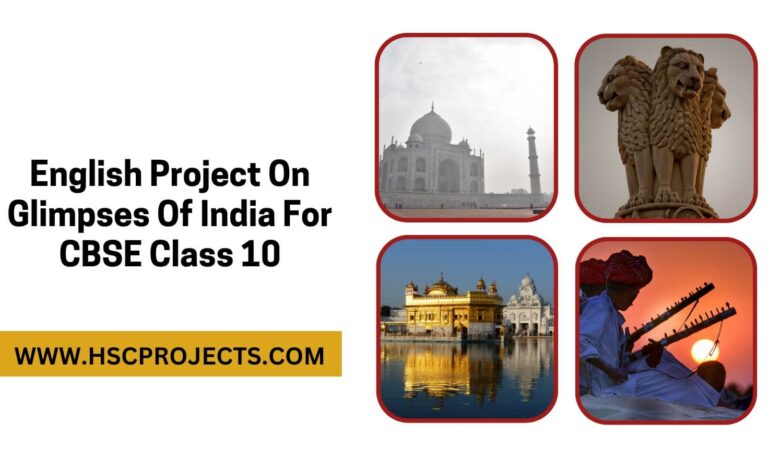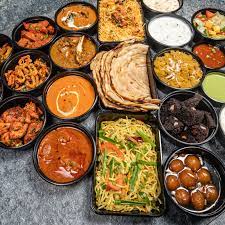
English Project On Glimpses Of India For CBSE Class 10
Introduction
India is a country rich in legacy, culture, and variety. India provides a wide variety of experiences that are distinctive and exciting, from the tranquil beaches of the south to the snow-capped Himalayan highlands in the north. The nation is a melting pot of civilizations because it is home to various religions, languages, traditions, and customs. India is best seen in glimpses, which highlight the nation’s diversity, history, and various cultural nuances. In this project, we’ll delve further into the various facets of India and discover its charm and distinctiveness.
Diversity
India is renowned for its varied traditions and culture, which change depending on the location. There are 29 states in the nation, and each has its own distinct dialect, menu, fashion, and festivals. For instance, the south of India is renowned for its rice-based cuisines, whereas the north of India is renowned for its spicy cuisine. The west is renowned for its street cuisine, while the east is famed for its sweets. The nation as a whole celebrates holidays like Diwali, Holi, Eid, Christmas, and Guru Nanak Jayanti with similar fervour. India’s diversity is part of what makes it so beautiful, and it is amazing to observe how people from all cultures get along and honour one another’s customs.
Beauty

Unmatched beauty may be seen in India’s landscapes, monuments, and people. Some of the most famous places on earth are found in this nation, including the Taj Mahal, one of the Seven Wonders of the World, and a UNESCO World Heritage site. Other architectural wonders that draw visitors from all over the world are the Golden Temple in Amritsar, the Hawa Mahal in Jaipur, and the Lotus Temple in Delhi.
India’s natural beauty is equally as captivating as its monuments. India offers a wide variety of experiences to its visitors, from the Himalayan mountains’ snow-capped peaks to Kerala’s backwaters. There are various national parks and wildlife sanctuaries in the nation, such as the Kaziranga National Park, Bandhavgarh National Park, and Ranthambore National Park, where tourists can observe the variety of animals.
The people of India, who are friendly and hospitable and greet visitors with open hearts, are the final component of India’s beauty. People in the nation are proud of their legacy and ready to share it with others, which helps to preserve the nation’s rich cultural heritage and traditions.
Festivals

India is a nation of festivals, and it observes a number of them throughout the year. India’s culture revolves around festivals, which provide a window into the nation’s voluminous history and customs. In India, some of the most well-known holidays are Diwali, Holi, Dussehra, Eid, Christmas, and Guru Nanak Jayanti.
Diwali sometimes referred to as the “Festival of Lights,” is widely observed throughout the nation. To symbolize the triumph of good over evil, people light lights and candles and decorate their homes with rangolis, flowers, and diyas.
The “Festival of Colours,” usually referred to as Holi, is another well-known holiday in India. People celebrate the spring festival by hurling colored powders and water at one another.
To commemorate Lord Rama’s victory over the demon king Ravana, Dussehra is observed. In several regions of the nation, it is observed with tremendous fervour, and plays retelling the Ramayana are performed.
Muslims around the nation celebrate Eid to commemorate the conclusion of the fasting month of Ramadan. To commemorate the event, people dress in new attire, go to mosques, and cook delectable cuisine.
Christians in India rejoice in the holiday season by singing carols, putting up Christmas trees, and giving gifts.
Sikhs commemorate Guru Nanak Jayanti, the anniversary of the founder of Sikhism, by celebrating it. People visit gurudwaras to make prayers and ask for blessings during this joyful occasion.
Cuisine

India is renowned for its varied, regionally-specific cuisine. Indian food is distinctive and delectable due to the combination of spices, herbs, and flavours. The geography, climate, and culture of the nation have a significant impact on its cuisine.
In North India, some of the most well-known foods are butter chicken, naan, tandoori chicken, and chole bhature. South Indian food is well known for its dosas, idlis, vadas, and sambar and is primarily vegetarian. Rasgullas, sandesh, and mishti doi are just a few of the delicious sweets that are a staple of East Indian cuisine. The popular street foods in West India include vada pav, pav bhaji, and bhel puri.
The range of spices used in Indian cuisine, such as cardamom, cumin, turmeric, and coriander, is also well-known. In addition to giving food flavour, these spices have a number of health advantages.
Finally, desserts are a necessary component of Indian food. Indian desserts, from ras malai to gulab jamun, are renowned for their flavour and texture throughout the world. Desserts are a crucial component of Indian cuisine as well as the culture and customs of the nation.
Personalities
India is home to numerous notable individuals who have made contributions and left their imprint on the world. Mahatma Gandhi, Jawaharlal Nehru, Rabindranath Tagore, Indira Gandhi, Mother Teresa, and Sachin Tendulkar are a few of the most well-known people from India.
The “Father of the Nation,” Mahatma Gandhi, was an important figure in India’s war for freedom. He is remembered for his nonviolent ideology and dedication to justice and the truth.
First Prime Minister of India Jawaharlal Nehru was a forward-thinking figure who helped to shape the nation’s destiny. He created a solid democratic system in India and built the groundwork for the country’s industrial and economic progress.
The Nobel Prize-winning poet, author, and philosopher Rabindranath Tagore is regarded as one of India’s greatest writers. He contributed significantly to the promotion of Indian literature and culture and wrote the national song of India.
The nation of India’s first female prime minister, Indira Gandhi, was an inspiring figure who helped to determine the country’s political and economic future. She is renowned for her decisive leadership and contribution to the expansion and advancement of the nation.
Catholic nun and Nobel laureate Mother Teresa spent her entire life in India helping the needy and underprivileged. She will be remembered for her dedication to helping people and her unselfish service.
Legendary cricketer Sachin Tendulkar is regarded as one of the best batsman in history. A generation of young cricketers has been motivated to achieve their aspirations by him, who serves as an inspiration to millions of cricket fans in India and around the world.
Cinema

One of the biggest film industries in the world is Indian cinema, or Bollywood. Hindi, Tamil, Telugu, and Bengali are just a few of the languages that the Indian film industry creates films in. It is also renowned for its distinctive storytelling and music.
Bollywood films are renowned for their vibrant song and dance routines, dramatic plotlines, and oversized characters. Many renowned actors, directors, and musicians who have made an impact on the world thanks to Indian cinema.
Bollywood actors Amitabh Bachchan, Shah Rukh Khan, Aishwarya Rai, and Priyanka Chopra are among the most well-known. These performers have helped Indian film develop and become more well-known thanks to their enormous fan bases in India and throughout the world.
In addition, Indian film has given the world some of the most recognisable motion pictures, including “Sholay,” “Mughal-e-Azam,” “Mother India,” and “Lagaan.” In addition to providing viewers with entertainment, these films have promoted Indian customs and culture over the world.
The expansion and improvement of the Indian economy have also been aided by Indian film. The film business employs thousands of people, including actors, directors, producers, and technicians, and brings in a sizable amount of money.
Music

The traditions and culture of India have long included music. Indian music has a rich history that encompasses classical, folk, devotional, and film music.
One of the oldest and most intricate musical traditions in the world is Indian classical music. Hindustani classical music and Carnatic classical music are its two main subgenres. These subgenres each have their own distinctive instrumentals, compositions, and singing.
Different parts of India have their own distinct folk music styles and instrumentation, which is very popular. The folk music genres Bhangra, Ghazal, Qawwali, and Baul are some of the more well-known ones.
Bhakti Sangeet, commonly referred to as devotional music, is a genre of music that is performed in churches, temples, and other places of worship as a service to God. Bhajans, kirtans, and aartis are all part of it.
Finally, Bollywood music, also referred to as cinema music, is the most well-known kind of music in India. It is a fusion of various musical styles and is well-known for its upbeat music and lyrics. Indian film music enjoys a sizable fan base both in India and abroad, which has helped Indian cinema become more well-known and famous.
Overall, Indian music is a vital component of the nation’s identity and reflects the nation’s rich cultural heritage and customs.
Progress
India has advanced significantly in a number of areas, including infrastructure, education, healthcare, and science and technology. India has become a global leader in a variety of industries and has aided in the expansion and advancement of mankind.
India has achieved major strides in the fields of biotechnology, information technology, and space technology. India has significantly aided the growth of the global IT industry by launching numerous satellites, including the Mars Orbiter Mission.
India has achieved great strides in the area of education in terms of expanding access to school and fostering literacy. To ensure that all children receive free and mandatory education, the government has implemented a number of programmes, including the Right to Education Act and the Sarva Shiksha Abhiyan.
India has achieved great strides in the healthcare sector in terms of expanding access to medical care and fostering public health. In order to provide healthcare services to millions of people who live in rural areas, the government has created a number of initiatives, including the Ayushman Bharat scheme.
Last but not least, India has made enormous strides in the construction of highways, airports, and ports. The National Infrastructure Pipeline is one of the programmes the government has started to advance infrastructure growth and economic development.
Overall, India’s success in several disciplines is evidence of its development and growth as well as its dedication to being a world leader.
Conclusion
India is a nation with a wide range of traditions and a rich cultural history. It is a land of festivals, cuisine, music, and films that showcase the distinctive individuality and personality of the nation. India has achieved enormous strides in a variety of areas, including infrastructure, education, healthcare, and science and technology, and has become a global leader in a number of industries.
India has remained a strong and dynamic country despite its difficulties, inspiring and enthralling people all over the world. With their varied cultures, religions, and customs, its citizens have aided in the nation’s expansion and development as well as helping to define its identity and character.
In conclusion, India’s glances are a call to travel and experience a nation that is rich in diversity and beauty. India is a nation that is worth experiencing and admiring because it has something to offer everyone, whether it is its festivals, cuisine, music, movies, or advancement.
Certificate
This is to certify that I, [Your Name], a student of CBSE Class 10 at [Name of School], have successfully completed the English project on “Glimpses Of India. ” This project aims to showcase the rich heritage, cultural diversity, natural beauty, festivals, cuisine, personalities, cinema, and progress of India.
During the course of this project, I had the wonderful opportunity to explore and delve into the various facets that make India such a unique and captivating country. The project allowed me to discover the vast diversity present in India, from the different cuisines, languages, and traditions in each state to the festivals that bring the entire nation together in joyous celebrations.
I thoroughly enjoyed learning about the breathtaking beauty of India, from its majestic monuments like the Taj Mahal to the serene landscapes of the Himalayas and the backwaters of Kerala. The warm hospitality and friendly nature of the people of India were truly heartwarming and left a lasting impression on me.
The research on famous personalities like Mahatma Gandhi, Jawaharlal Nehru, Rabindranath Tagore, and others made me admire their contributions and impact on India’s history and culture. Their achievements and ideologies continue to inspire generations.
The exploration of Indian cinema, especially Bollywood, and its influence both within India and globally, was fascinating. I learned about legendary actors and their remarkable journeys, which gave me a deeper appreciation for Indian cinema’s rich storytelling and music.
Indian music, with its classical, folk, devotional, and film genres, amazed me with its diversity and beauty. Understanding the role of music in Indian culture and its impact on society was truly enlightening.
Lastly, learning about India’s progress in various fields, such as infrastructure, education, healthcare, and technology, made me proud of the nation’s achievements and its continuous strive for growth and development.
I am immensely grateful to my English teacher for guiding and supporting me throughout this project. Their encouragement and valuable feedback helped me present the information in a coherent and engaging manner.
I would also like to express my gratitude to my family and friends for their constant support and encouragement during this project.
Completing this project on “Glimpses Of India” has been a fulfilling and enriching experience. It has instilled in me a deeper appreciation for my country’s rich cultural heritage and diversity. I hope that my project will inspire others to explore and cherish the beauty of India.
[Your Name][Class 10, CBSE][Name of School][Date]In order to download the PDF, You must follow on Youtube. Once done, Click on Submit
Follow On YoutubeSubscribed? Click on Confirm
Download English Project On Glimpses Of India For CBSE Class 10 PDF






